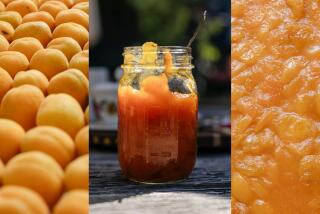An Elusive Fruit Fit for Royalty
- Share via
My 77-year-old father strides toward me, his “Fairfax flyer” shopping cart bobbling behind him, as I eagerly wait at the farm stand. He peers at the fragrant mountain of small, less-than-gorgeous fruit before us.
“Best apricot you’ll ever eat, sir,” the farmer extols, offering a freckled, sun-blushed nugget.
Don’t we know it. Every spring, anywhere from mid-May to early June, we begin the wait for Royal Blenheim apricots. The last vestige of true apricot flavor, this variety is rarely seen in supermarkets anymore. The rosy, tree-ripened apricots are often marked or blemished--flaws undesirable in modern retail marketing but a sign of sweetness to the knowing consumer. Replaced by new, less fragile varieties that are sadly short on flavor, Royal Blenheims are the stuff of legend, backyard crops and now, some farmers’ markets. With one bite, memories come flooding back.
In the ‘50s, my father used to take me with him to do the family shopping at BusyB Market in East Hollywood. He didn’t cook, but Dad knew the butcher and the produce man, and as with everything else he does, he chose the best. During the brief apricot season (usually four to six weeks), we readily found Royal Blenheims. But we didn’t know variety names back then; we didn’t have to.
We reached apricot nirvana when we moved to a house in Burbank with a glorious Royal Blenheim tree of our own in the backyard. Some years, we had a bounteous crop. Other seasons, we lost the battle to the birds and squirrels. My mother fought valiantly; the tree was often festooned with foil and netting.
We struck gold when a great harvest coincided with a visit by my paternal grandmother from Israel. She would send us kids to collect the ripest apricots and then make preserves that harnessed the fruit’s essence--honeyed, with a whisper of tartness. Something between a compote and jam, it tasted of the sun. We ladled it over ice cream and slathered it on toast. We ate it by the spoonful.
It’s been 23 years since my parents moved from Burbank. After years of settling for picture-perfect but tasteless Castlebrite apricots from the supermarket, my father despaired of ever tasting the real thing again. Then, six years ago, I discovered Royal Blenheims at the Santa Monica Farmers’ Market.
Now, the Wednesday mornings my father accompanies me there take me back to those days when I was his girl--not a distracted mother of three--and divine apricots were plentiful. We make a morning of shopping, often finishing with an early lunch. Whenever we’re lucky enough to find Royal Blenheims past June, I take an apricot surprise to my parents’ Fourth of July gathering--homemade ice cream, a tart or something more familiar.
At the beginning of the season, the supply of apricots seems endless. I squander them, eating them like candy, smashing the ripe-to-bursting fruit with a fork onto toast. But as the season winds down, I begin to focus on capturing the moment, storing the taste. And that’s when I make my grandmother’s preserves.
(BEGIN TEXT OF INFOBOX / INFOGRAPHIC)
Safta Rachel’s Fresh Apricot Preserves
Makes 2 to 3 cups
*
2 pounds very ripe apricots
2 1/2 cups granulated sugar
lemon juice, optional
*
Wash and dry apricots. Halve and seed them and place in large, wide nonreactive pot with heavy bottom. Pour sugar over apricots and let stand several hours, preferably overnight, to draw out juices. * Bring mixture to boil over medium heat, uncovered. Reduce heat to low and continue to boil gently for 45 minutes, making sure liquid is always bubbling and stirring often with a wooden spoon to keep preserves from sticking. Do not allow to scorch. * Put small amount of preserves on plate, allow to cool briefly, and test for thickening with your finger. The preserves should mound, not drip off your fingertip, and the fruit should still be chunky. For thick preserves, continue to cook until desired consistency is reached, up to 1 hour longer. If preserves become too thick, add a little water. Taste and correct sweetness with lemon juice if needed. Pour into clean, dry glass jars and refrigerate. Preserves will keep up to one month and may also be frozen or sealed in sterilized jars.
More to Read
Eat your way across L.A.
Get our weekly Tasting Notes newsletter for reviews, news and more.
You may occasionally receive promotional content from the Los Angeles Times.










